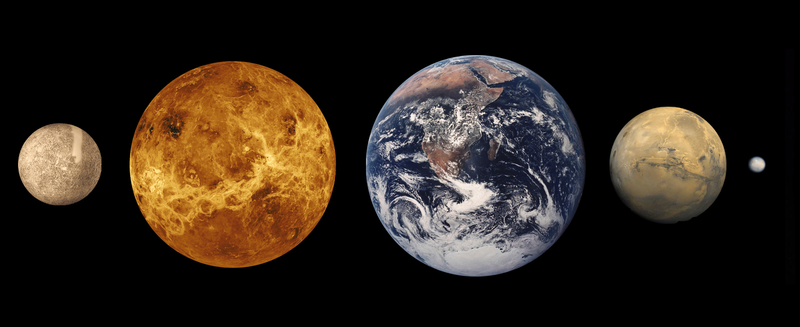 A terrestrial planet is a planet which has solid surfaces and is primarily composed of silicate racks and/or metals. There are 4 known terrestrial planets in our solar system – Mercury, Venus, Earth and Mars, which are all inner planets and one terrestrial dwarf planet, Ceres, located in the asteroid belt. These planets share similar characteristics such as proximity to the soon, few or no moons, absence of planetary rings such as Saturn's, relatively weaker magnetic fields and closely spaced orbits. They are also relatively smaller compared to the ‘gas giants' Jupiter, Saturn, Uranus and Neptune, which are located beyond the asteroid belt or “outer planets”.
A terrestrial planet is a planet which has solid surfaces and is primarily composed of silicate racks and/or metals. There are 4 known terrestrial planets in our solar system – Mercury, Venus, Earth and Mars, which are all inner planets and one terrestrial dwarf planet, Ceres, located in the asteroid belt. These planets share similar characteristics such as proximity to the soon, few or no moons, absence of planetary rings such as Saturn's, relatively weaker magnetic fields and closely spaced orbits. They are also relatively smaller compared to the ‘gas giants' Jupiter, Saturn, Uranus and Neptune, which are located beyond the asteroid belt or “outer planets”.
Terrestrial planets have similar structures – a core composed of heavy metals which is usually iron, solid surfaces of craters, canyons, mountains and volcanoes and secondary atmospheres (generated through volcanic activity and comet impacts), as opposed to the gas giants which has primary atmospheres (captured directly from the original nebula). Note that while the moon has similar structure, it doesn't have an iron core. Plutoids are also similar to terrestrial planets in that they have solid surfaces; but instead or rocky surfaces, they are composed of icy materials.
Mercury is one dense planet composed of iron and nickel, with a very thin atmosphere. Venus has a thick atmosphere, mostly of carbon dioxide, which causes a greenhouse effect. Earth has the highest density among these planets with an atmosphere composed of elements that are conducive for human habitation and Mars has a rocky red surface and a thin atmosphere. Note that among these 4, only Earth and Mars has moons; Earth has one and Mars has two). Extra-solar terrestrial planets are the subject of much interest, as people naturally want to know of the existence of other planets that are habitable for humans, or for the theoretical extraterrestrial beings.
